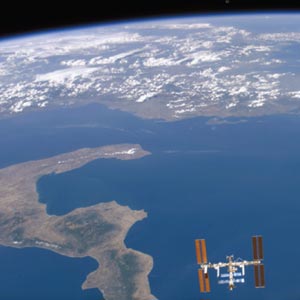Regulations must be tightened if we are to continue to reap the benefits of space

In cosmic terms, half a century is a mere blink of an eyelid. But for humankind, much has happened in the 50 years since Sputnik 1 — the first artificial satellite — was launched by the Soviet Union on 4 October 1957. Despite being little more than a sphere of metal that let out radio-frequency beeps, Sputnik 1 triggered a thrilling space race that rapidly led to astronauts orbiting the Earth and then walking on the Moon before the 1960s were out (see “Sputnik’s legacy”). Since then, spacecraft have visited other planets, flown past comets and even landed on an asteroid.
To mark the 50th anniversary of Sputnik 1, this special issue of Physics World looks back at the story of that particular mission and examines some of the benefits of modern satellite technology. Satellites, of course, underpin communication networks and are essential for observing the Earth to monitor the effects of, say, deforestation or climate change (pp10–11, print edition only). Indeed, the US’s Global Positioning System (GPS) is proving so vital for navigation and surveying that Europe, Russia and China are all planning rival satellite systems (see “Global navigation flies high”).
However, all is not rosy up above. The International Space Station (ISS) has been a successful collaboration between the US, Europe and the Soviet Union, and it is giving us insights into how the human body reacts to long periods in orbit (see “Physics up above”). But the ISS has swallowed such vast sums of money (NASA alone is estimated to have contributed $100bn) that many have questioned if the scientific pay-back from the 200 or so experiments carried out on the station in low-gravity conditions has been sufficient. A lot is resting on the European Space Agency’s Columbus research module, which is set to be deployed later this year.
Another concern is the potential weaponization of space. Satellites are sitting ducks for enemy nations, which might find it tempting to use a missile to knock out, say, a crucial military spy satellite. Moreover, when China destroyed an ageing weather satellite earlier this year in a test of its nascent antisatellite weapon system, the explosion created some 2500 new trackable pieces of “space junk” — and increased the chances of a low-Earth-orbiting satellite colliding with another object by up to 30% (see “Our orbiting junk yard”).
There are estimated to be at least 100,000 objects with a diameter of 1 cm or more orbiting at high speeds around our planet — ranging from spent rocket stages and disused satellites to smaller items like astronauts’ rubbish bags. Scientists have made good progress in developing systems to track and catalogue this debris, but more needs to be done to persuade nations to prevent further space junk being created in the first place.
“Mitigation guidelines” endorsed by the United Nations (UN) earlier this year are the right way forward in this regard by discouraging nations from intentionally destroying satellites and also bringing used satellites safely back to ground. The problem is that the guidelines are entirely voluntary. Now is therefore a good time to update and clarify the UN’s Outer Space Treaty, which came into force 40 years ago this month. Ratified by nearly 100 nations, the treaty forbids nuclear weapons from being placed in space, but says nothing about who, for example, should pay for the financial consequences of a satellite being wilfully destroyed. Revamping the treaty could ensure that we continue to enjoy the benefits of satellite technology for another 50 years.



